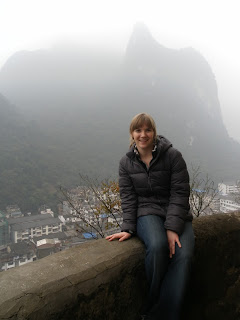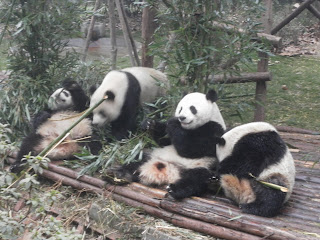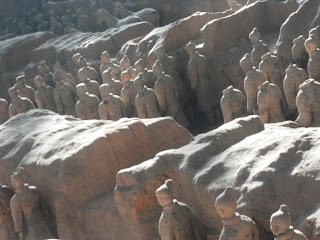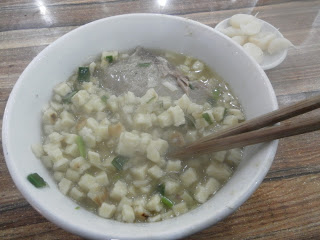Yangshuo is a town near Guilin, in Guangxi province. It's an area known for it's limestone karst mountains and scenic rivers. It was also fun to see lots of bamboo, mandarin oranges, and pomelo there. It was cool and overcast, but it didn't rain until the day I left. I spent three days in and around Yangshuo - walking, cycling, hiking, reading, and meeting interesting people.
This is probably the closest we can get to traveling together without actually traveling together. As time and internet access allow, I'll try to keep you as up to date as possible as to what I'm up to when I'm on the road. Hope you enjoy the pictures, videos, and stories. It's fun to be able to share my experiences! :)
Tuesday, January 29, 2013
Monday, January 28, 2013
Days 4-6: Chengdu
I slept for nearly 12 hours of the 16-hr train ride to Chengdu, and the last 4 hours went quickly with reading, writing, and watching the landscape change from dry and brown to wet, green patches of farmland and vegetable gardens. It was great to have a hot shower at the hostel when I got there, after spending the last two nights on sleeper trains.
The first evening I took a city bus to Jin Li Street, which was full of tourists and decked out with red and pink paper lanterns in anticipation of the Chinese New Year. My dinner was a smattering of Sichuan snacks: pineapple sticky rice served in the bottom of a hollowed pineapple, spicy tofu kebabs, and a beef & pepper stuffed pita sandwich.
The next morning I got up early to visit the Panda Breeding Base in time for the morning feeding. The pandas were adorable!!! They climbed on each other and up trees, they rolled on their backs and leaned against each other, and ate bamboo like it was their job, using all four limbs to grip and tear the stalks. They're such funny-looking animals - just as loveable and cuddly as the stuffed toy versions make them out to be, with those big 'sad' eyes and lazy mannerisms and sort of playfulness. I could have just watched them for hours. The Base was interesting too, with lots of good information about the pandas and their life cycles. They're incredibly fragile at birth and through the first year of life, with only about a 50% survival rate of the cubs born at the Base, receiving the very best care. There were red pandas there too, and peacocks around the grounds.
In the afternoon I picked up a map and did a self-led walking tour of Chengdu. First I walked up Renmin Lu to the giant statue of Chairman Mao in the central square, then cut west to the People's Park. It really is "the people's" - they use it to the utmost. Aerobics, ballroom dancing, Chinese hacky-sack, sidewalk water calligraphy, skateboarding, ear-cleaning (yes, it's a thing), bird-walking (also a thing), posting ads and meeting to talk business, practicing musical instruments, reading, walking, singing Chinese opera, sleeping, and drinking in tea houses and gardens. It's a park that breathes and bustles with activity.
From the park, I continued north to "Big Alley, Small Alley", an area recreated to have an "old China" feel with traditional architecture and pedestrian-only streets, filled with art, shops, tea houses, and restaurants. It absolutely succeeded in being charming, but was too expensive to warrant any shopping or eating for me. I enjoyed strolling there anyway.
My next destination was less affected and more culturally revealing - Wenshu Temple and Monastery in the north-east of the city. Wenshu is an active temple complex with a more solemn feel than some of the other Buddhist temples I've visited, and lots of worshippers, not just sightseers. Candles and incense were burning in every courtyard and in front of every shrine. The grounds were quiet and beautiful. I got the impression that while religion is largely disregarded in Beijing, it may thrive more away from the capital. But I don't know how true that is. Communism's reach was very long and its effects very lasting.
In the evening I took a city bus (with some help from a friendly student) to the Tibetan Quarter down near Wuhou Temple and Jin Li Street. The streets there were sort of gritty, but they had a colorful and distinctly non-Han Chinese vibe. Tibetans are beautiful people. Many were wearing the traditional dress of herders - colorful, thick fabrics. Dark eyes and hair, wind-rosed cheeks. I followed a sign to go up a dilapidated staircase to a Tibetan restaurant where I turned out to be the only non-Tibetan. Guess that means the food was authentic! I had yak meat and potato stew with bread and black butter tea.
On Sunday, I visited an international fellowship for worship in the morning and then spent most of the rest of the day 'networking' with some folks I'd previously been put in contact with via e-mail. I got to talk and pray with some really great people doing really fascinating work with some minority people groups. I was encouraged and inspired by their stories.
In the evening I went out with some friends I'd made at the hostel where I was staying. We had dumpings, then sat around in the lounge back at the hostel with a couple of Tsingdaos. So I spent my last evening in Chengdu talking and laughing with a Swiss exchange student, a French guy travelling and working on an "extended gap year", and a young Israeli on holiday. These are some of the moments that make me love travelling. :-)
Day 3: Xi'an
The night train from Pingyao arrived in Xi'an at 6:15am, so I got an early start exploring the city. After a quick breakfast near the station, and washing up a little in the bathroom at McDonalds (gotta do what you can!), I took the first bus I saw heading to the Terracotta Warriors. I visited the Exhibition Room before going to the pits, to better understand what I was about to see. The warriors really are amazing. Every single one is different, even down to the details of their facial expressions, their hairstles, their belts...and all to guard a tomb. There are 3 pits of warriors being excavated. The third and smallest pit houses what appears to be the headquarters, where a group of generals stand facing each other. The second pit has mostly collapsed, but fascinating details of warriors, chariots, and horses can be seen there. The 1st pit is the most impressive, with columns of standing warriors. Of course, the whole thing would be much more impressive if they weren't enclosed in a big warehouse-type room with ropes all around and tourists like myself snapping photos...but what can you do?
Back in the city, there is a Muslim Quarter just north of the Drum and Bell Towers in the main square. Tucked into the narrow market lanes with stalls of peanut cakes, dried persimmons, roasted lamb skewers, noodles, and flatbread, is the Great Mosque, where Chinese Muslims have been going to pray since it was built in 742.
For lunch, I had a bowl of yangrou paomo - a hearty dish of thick doughy bread cubes in savory broth with slices of tender lamb.
Back in the city, there is a Muslim Quarter just north of the Drum and Bell Towers in the main square. Tucked into the narrow market lanes with stalls of peanut cakes, dried persimmons, roasted lamb skewers, noodles, and flatbread, is the Great Mosque, where Chinese Muslims have been going to pray since it was built in 742.
For lunch, I had a bowl of yangrou paomo - a hearty dish of thick doughy bread cubes in savory broth with slices of tender lamb.
I spent the rest of the day walking around the city. Stumbled across a little art district with stalls selling calligraphy brushes and paintings and handicrafts in what looked like a very old section of the city near the south gate. Just before dusk, I climbed up on the city wall and walked along the top where it was quiet and peaceful as the lanterns lit up.
Xi'an is busy and polluted and modern, but something about the ramparts and the bustle and the diversity gives it an old feeling and reminds you that this city was the end of the ancient Silk Road, where merchants and scholars and warriors and nomads travelled from across the continent long before the days of sleeper trains.
Subscribe to:
Posts (Atom)



























































